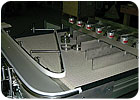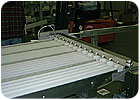

Accumulators have been around since assemblers first started using conveyors almost 100 years ago. Industries that rely on batching of products are some of the biggest users of the technology.
Accumulator conveyors are typically used because products can rapidly be put back in line for further processing. Specifically, they can maintain the orientation of the product, accumulate products without any surface damage from the direct contact with each other, or redirect products to other conveyors to ease the congestion.
There are four distinct approaches to accumulation: First in, first out (FIFO); last in, first out (LIFO); mass accumulation; and buffers. The first two approaches deal directly with the order that the manufacturer wants the product to be in at the conclusion of the manufacturing process. With FIFO and LIFO systems, however, customers need some method to track their products through the entire production process.
Mass accumulation deals with accumulating vast quantities of product in a specific area. But, it does not offer tracking capabilities and, as a result, many companies are moving away from this process. Buffers address the need for product to accumulate to accommodate the servicing or maintenance of a particular part of the manufacturing line. This allows the process to continue in spite of losing one or more pieces of machinery to either emergency or routine servicing.
No matter what type of system is used, accumulators must be sized to accommodate the capacity required. Machine builders and systems integrators need four basic parameters to design an effective system: the shape, dimension and weight of the product; how the product will be presented; how much physical space exists in the manufacturing site; and the speed at which the product needs to be moved.
Typically, most systems fall into two distinct categories: serpentine systems and alpine systems. Serpentine systems move horizontally, similar to the natural movement of a snake. Alpine systems move in a descending and ascending vertical pattern, similar to a roller coaster. In most cases, serpentine systems are required for products that must not accidentally tip over, while alpine systems are required when minimum floor space is available on an assembly line. However, exceptions to these rules do exist.
Successful Applications
There are many intricacies of accumulation. For instance, consider the following material handling applications.
A large industrial manufacturer wanted to move some plastic components across its assembly line. The product was nearly rectangular in shape. The manufacturing site offered no overhead space to accommodate a typical ascending-descending alpine system and floor space was at a premium. To say that this project was intricate would be the understatement of the century.
To solve the problem, the company installed an alpine system that included a reverse downward spiral. Product that goes down must come up. To get this design to work, engineers had to incorporate a crossover approach that allowed the product to descend and ascend in a unique parallel fashion. Without this approach, it would have been almost impossible to solve this intricate problem.
A large medical device manufacturer needed a way to move syringes in pucks. The product was round and thin, and the company was not particularly concerned about the orientation of the product. However, it was critical that the syringes not be dumped out of their pucks. A simple mass accumulation system using a traditional accumulation table approach solved the problem.
Normally, mass accumulation is the quickest and easiest form of accumulation. Unfortunately, there is a lot of wasted space with most accumulation table scenarios. In this particular case, the intricacies of keeping the syringes in their pucks created a big challenge.
By carefully considering many different variables, such as product weight, height and manufacturing speed, the engineering team was able to allow these syringes to gently accumulate in mass without spilling over. A host of guards and diverters moved the product gently to the end of the accumulation table.
A large pharmaceutical company needed to move some oddly shaped prescription bottles and vials. It was critical that these bottles not tip over. As a result, a serpentine system was required. It was also important that the leading edge of the product be rotated evenly throughout its travels.
Each vial was approximately 2 inches wide. At a production speed of 300 vials per minute, some 600 inches of product would be produced in 1 minute. Thus, accumulation of 5 minutes of production time would require 250 feet of conveyor.
Conquering accumulation intricacies is not easy. But, as long as the product shape, dimension, weight and orientation requirements are clearly understood, in addition to the available space at the manufacturing site and required production speed, most conveyor projects will succeed without a hitch.
Problems, glitches and mistakes typically occur when one or more parties fail to communicate the required variables to the other. Clear communication is critical to the ongoing success of any conveyor project.
Before tackling a project, engineers should ask the following questions:
- Have we given the vendor all the information it needs?
- Have we clearly communicated to the conveyor supplier what parts we need to complete this task?
- Has the vendor recommended the best possible conveyor system based on the manufacturing parameters that we provided?